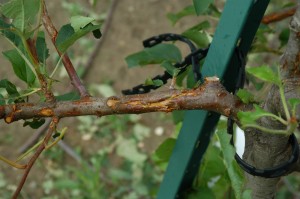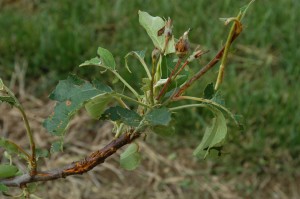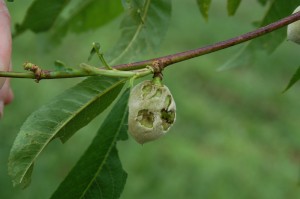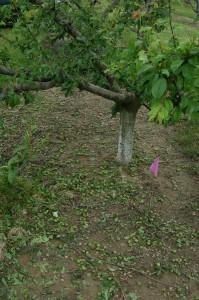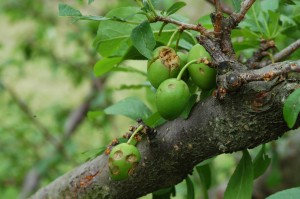A major rain and hail storm occurred at the Rutgers Agricultural Research and Extension Center, Bridgeton during last Thursday evening, 22May. Hail stones the size of marbles fell for about 15 minutes.
Research Plots
Experimental peach, nectarine, plum, and apple orchards and grape vineyards suffered severe injury from the storm, along with many newly planted vegetable transplants. Considerable leaf shredding, damage to stems, and fruit injury was observed on all trees and vines (see photos). Many fruit and leaves were on the ground. Of the remaining fruit in the trees, about 75 to 100% were visibly injured; bruises will become more evident later. Some of the fruit were literally cut in half. Only large scaffold limbs and trunks on older trees were not injured, being protected by their thick bark.
Moderate and severely injured peach fruit that are still attached to the trees are more likely to abscise during the upcoming “June drop”. However, fruit with minor injury often heal over and simply form a scar. The warm sunny weather over the last three days has helped this healing process. These fruit, if they remain on the trees, along with the small percentage of uninjured fruit, may allow some experiments to move forward.
On the bright side (for pathologists), there are a significant number of blossom blight cankers present in the test blocks. These were not affected by the hail and so will be assessed as usual for evaluating the efficacy of the bloom fungicide sprays. Also, some green fruit rot (brown rot) may occur on the damaged fruit, which will raise the inoculum level for brown rot development at harvest. This, again, is good for pathology studies.
Commercial Orchards
The hail storm was apparently localized in occurrence. Nevertheless, any commercial peach grower who suffered a similar major, if not complete, loss should at minimum maintain sulfur or captan cover sprays. These sprays are necessary to prevent shoot infections and therefore build-up of scab inoculum for next year. They will also help lessen brown rot development on any remaining fruit and the subsequent formation of mummies. Hand removal of fruit is another option, although this may be expensive for a non-producing block.
For orchards with a partial crop, continue the standard cover spray program. Monitor the orchard for development of green fruit rot, as well as blossom blight cankers. Nothing unusual needs to be done right now (5 days after the hail) since fruit and other tissue are not currently susceptible. However, if one or both of these inoculum sources are present at above average levels, then the risk of brown rot infection at harvest will be greater. In this case a three-spray pre-harvest program is suggested. For details on programs, see the article “Integrated Preharvest Fungicide Programs for Brown Rot” in the July 8, 2013 issue of P&PA.
